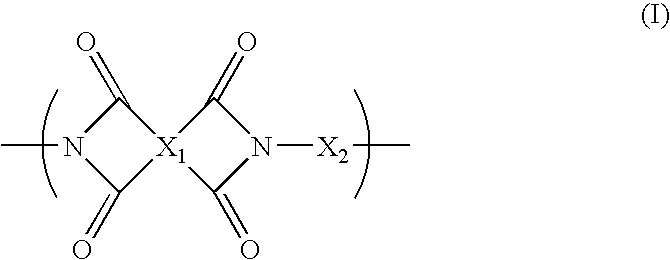Blend Polymer Membranes Comprising Thermally Rearranged Polymers Derived from Aromatic Polyimides Containing Ortho-Positioned Functional Groups
- Summary
- Abstract
- Description
- Claims
- Application Information
AI Technical Summary
Benefits of technology
Problems solved by technology
Method used
Image
Examples
example 1
Synthesis of poly(6FDA-HAB) Polyimide
[0057]The aromatic poly[2,2′-bis-(3,4-dicarboxyphenyl) hexafluoropropane dianhydride-3,3′-dihydroxy-4,4′-diamino-biphenyl] (poly(6FDA-HAB)) polyimide containing pendent —OH functional groups ortho to the heterocyclic imide nitrogen in the polymer backbone was synthesized from 2,2′-bis-(3,4-dicarboxyphenyl) hexafluoropropane dianhydride (6FDA) and 3,3′-dihydroxy-4,4′-diamino-biphenyl (HAB) in NMP polar solvent by a two-step process involving the formation of the poly(amic acid) followed by a solution imidization process. Acetic anhydride was used as the dehydrating agent and pyridine was used as the imidization catalyst for the solution imidization reaction. For example, a 250 mL three-neck round-bottom flask equipped with a nitrogen inlet and a mechanical stirrer was charged with 5.9 g (27.3 mmol) of HAB and 40 mL of NMP. Once HAB was fully dissolved, a solution of 6FDA (12.1 g, 27.3 mmol) in 40 μL of NMP was added to the HAB solution in the flas...
example 2
Preparation of Blend Polymer Membrane from Poly(6FDA-HAB) Polyimide and Polyethersulfone (PES) (Abbreviated as poly(6FDA-HAB) / PES)
[0058]The poly(6FDA-HAB) / PES blend polymer membrane was prepared as follows: 3.0 g of poly(6FDA-HAB) polyimide synthesized in Example 1 and 1.5 g of polyethersulfone (PES, purchased from BASF Corporation) were dissolved in a solvent mixture of 12.0 g of NMP and 12.0 g of 1,3-dioxolane. The mixture was mechanically stirred for 2 hours to form a homogeneous casting dope. The resulting homogeneous casting dope was allowed to degas overnight. The poly(6FDA-HAB) / PES blend polymer membrane was prepared from the bubble free casting dope on a clean glass plate using a doctor knife with a 20-mil gap. The membrane together with the glass plate was then put into a vacuum oven. The solvents were removed by slowly increasing the vacuum and the temperature of the vacuum oven. Finally, the membrane was dried at 200° C. under vacuum for at least 48 hours to completely re...
example 3
Preparation of Polybenzoxazole / PES Blend Polymer Membranes (PBO(6FDA-HAB) / PES-450C and PBO(6FDA-HAB) / PES-400C) from Poly(6FDA-HAB) / PES Blend Polymer Membrane by Heat Treatment
[0059]The poly(6FDA-HAB) / PES blend polymer membrane was thermally heated from 50° C. to 400° C. or 450° C. at a heating rate of 5° C. / min under N2 flow. The membrane was hold for 1 hour at 400° C. (to make PBO(6FDA-HAB) / PES-400C blend polymer membrane) or 450° C. (to make PBO(6FDA-HAB) / PES-450C blend polymer membrane) and then cooled down to 50° C. at a heating rate of 5° C. / min under N2 flow to yield polybenzoxazole / PES blend polymer membranes (PBO(6FDA-HAB) / PES-400C and PBO(6FDA-HAB) / PES-450C).
PUM
| Property | Measurement | Unit |
|---|---|---|
| Temperature | aaaaa | aaaaa |
| Temperature | aaaaa | aaaaa |
| Volume | aaaaa | aaaaa |
Abstract
Description
Claims
Application Information
 Login to View More
Login to View More - R&D
- Intellectual Property
- Life Sciences
- Materials
- Tech Scout
- Unparalleled Data Quality
- Higher Quality Content
- 60% Fewer Hallucinations
Browse by: Latest US Patents, China's latest patents, Technical Efficacy Thesaurus, Application Domain, Technology Topic, Popular Technical Reports.
© 2025 PatSnap. All rights reserved.Legal|Privacy policy|Modern Slavery Act Transparency Statement|Sitemap|About US| Contact US: help@patsnap.com



